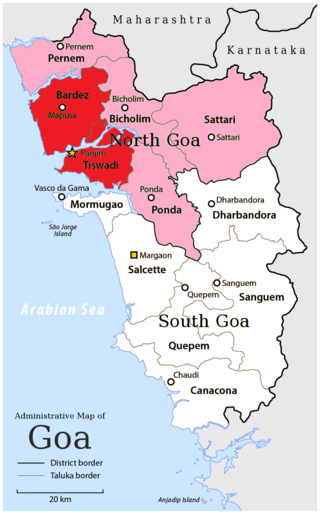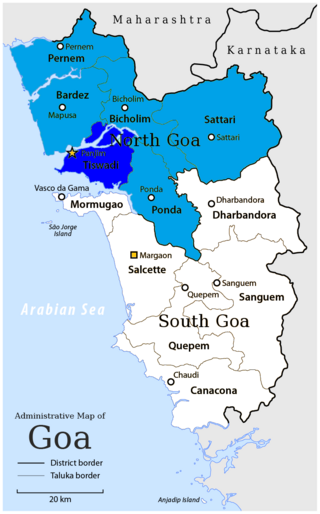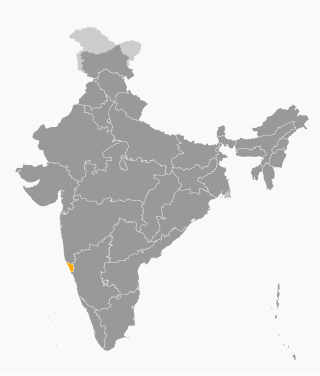Old Goa is a historical site and city situated on the southern banks of the River Mandovi, within the Tiswadi taluka (Ilhas) of North Goa district, in the Indian state of Goa.

Panaji is the capital of the Indian state of Goa and the headquarters of North Goa district. Previously, it was the territorial capital of the former Portuguese India. It lies on the banks of the Mandovi river estuary in the Tiswadi sub-district (taluka). With a population of 114,759 in the metropolitan area, Panaji is Goa's largest urban agglomeration, ahead of Margao and Mormugao.

Bicholim, is a small town and a municipal council in North Goa district in the state of Goa, India. It is the headquarters of the Concelho (county) of Bicholim, one of seven that make up the Novas Conquistas, territories added to Goa comparatively later than the first three of the Velhas Conquistas. The town is located about 30 km (19 mi) from the state capital of Panaji. It is in the mining heartland of Goa.

North Goa district is one of the two districts that constitutes the state of Goa, India. The district has an area of 1,736 square kilometres, and is bounded by Kolhapur and Sindhudurg districts of Maharashtra state to the north and by Belgavi district of Karnataka to the east, by South Goa district to the south, and by the Arabian Sea to the west.

Porvorim, is the de facto legislative and executive capital of the state of Goa as both the Goa Legislative Assembly and Secretariat are functioning from the same complex in the region of Alto Porvorim in porvorim.(Alto – Portuguese word meaning high or upper). It is also the De facto judicial capital of Goa. The High Court of Bombay at Goa is now functioning from here in a new building complex overlooking the Mandovi river. Earlier it was functioning from the Lyceum complex in Panaji. Porvorim is situated on the right bank of the Mandovi River, as de jure capital of Goa, Panaji is located on the opposite bank. Porvorim is considered an upmarket residential hub as it lies on the Mumbai–Goa highway NH66. Goa's largest shopping centre – Mall De Goa – is situated here.

Conspiracy of the Pintos, also known as the Pinto Revolt or the Pinto Conspiracy, and in Portuguese as A Conjuração dos Pintos, was a rebellion against Portuguese rule in Goa in 1787.
The Konkani people are an Indo-Aryan ethnolinguistic group native to the Konkan region of the Indian subcontinent. They speak various dialects of the Konkani language. Following the Konkani language agitation, Konkani became the premier official language of Goa state, while Mahratti remains as the associate official language of Goa. Konknni is also spoken by populations in Karnataka, Maharashtra, Damaon, Kerala, & Gujarat. A large percentage of Konkani people are bilingual.

The Ponte Conde de Linhares, often shortened to Ponte de Linhares is a 3.2 km (2.0 mi) long causeway connecting Ribandar to the main city of Panjim in Goa, India. It runs along the flood plains of the Mandovi River and is surrounded by various salt pans. There are ducts which act as tide controls. The Ponte Conde de Linhares was built in 1633–34 under the direction of the then Viceroy of Portuguese India, Miguel de Noronha, 4th Count of Linhares, after whom it is named. The bridge is often said to have been the longest in the world at 3.2 km (2.0 mi) when it was completed in 1634.
The island of Divar lies in the Mandovi river in the Indian state of Goa.

Antonio Francisco Xavier Alvares was initially a priest in the Roman Catholic Church in Goa. He joined the Malankara Syrian Orthodox Church and was elevated to Metropolitan of Goa, Ceylon and Greater India in the Malankara Syrian Orthodox Church.
This is a timeline of Goan history. It overlaps with the histories of other regions in South Asia, the Indian subcontinent, and colonial powers that influenced the region, including Portugal.
Goans is the demonym used to describe the people native to Goa, India, who form an ethno-linguistic group resulting from the assimilation of Indo-Aryan, Dravidian, Indo-Portuguese, Austro-Asiatic ethnic and/or linguistic ancestries. They speak different dialects of the Konkani language, collectively known as Goan Konkani. "Goanese", although sometimes used, is an incorrect term for Goans.

Tiswadi, formerly known as Ilhas, is a taluka in the district of North Goa, situated in the Indian coastal state of Goa. It is an estuarine island situated on the confluence of the Mandovi and Zuari rivers. It was one of the first territories to be annexed by the Portuguese in the 16th century. Both the state capital Panaji, and the erstwhile capital Old Goa lie within the sub-district. It is the biggest and the most populated of the six major islands between the Mandovi and Zuari rivers.
St. Cruz or Santa Cruz is a village located next to the city of Panaji, capital of the Indian state of Goa. It is located on the island of Tiswadi, one of the talukas in the state of Goa.

The Battle of Raichur was fought between the Vijayanagara Empire and the Sultanate of Bijapur in 1520 in the town of Raichur, India. It resulted in a decisive victory for Vijayanagara forces, and the Bijapur ruler was defeated and pushed across the river Krishna.
History of Goan Catholics recounts the history of the Goan Catholic community of the Indian state of Goa from their conversion to Christianity to date.

The Portuguese conquest of Goa occurred when the governor Afonso de Albuquerque captured the city in 1510 from the Adil Shahis. Old Goa became the capital of Portuguese India, which included territories such as Fort Manuel of Cochin, Bom Bahia, Damaon, and Chaul. It was not among the places Albuquerque was supposed to conquer. He did so after he was offered the support and guidance of Timoji and his troops.

Goa is a state on the southwestern coast of India within the Konkan region, geographically separated from the Deccan highlands by the Western Ghats. It is bound by the Indian states of Maharashtra to the north, and Karnataka to the east and south, with the Arabian Sea in the west. It is India's smallest state by area and fourth-smallest by population. Goa has the highest GDP per capita among all Indian states, two and a half times as high as the GDP per capita of the country as a whole. The Eleventh Finance Commission of India named Goa the best-placed state because of its infrastructure, and India's National Commission on Population rated it as having the best quality of life in India. It is the second-highest ranking among Indian states in the human development index.

The following outline is provided as an overview of and topical guide to Goa:























